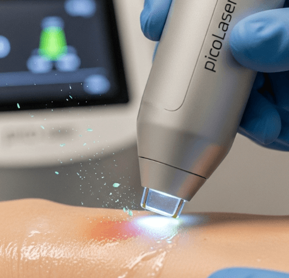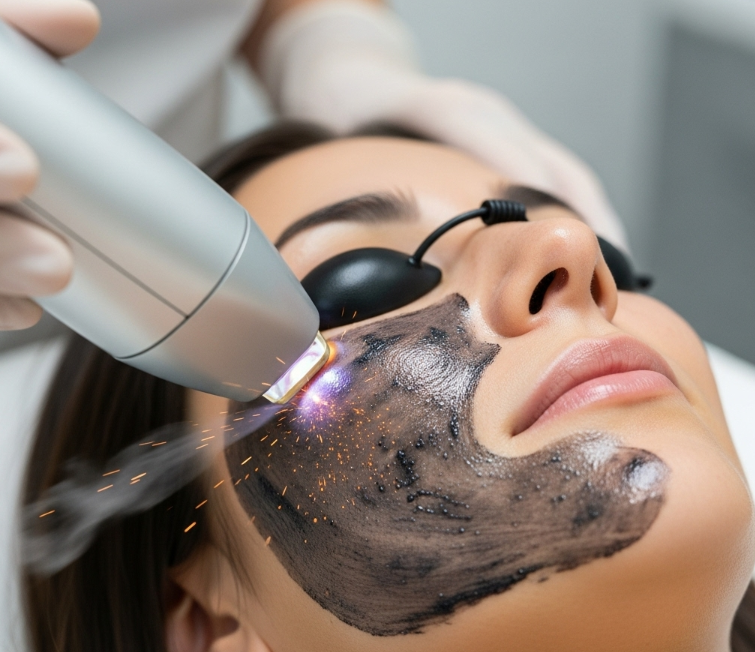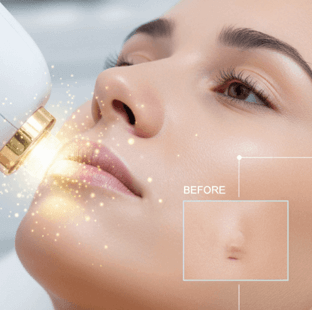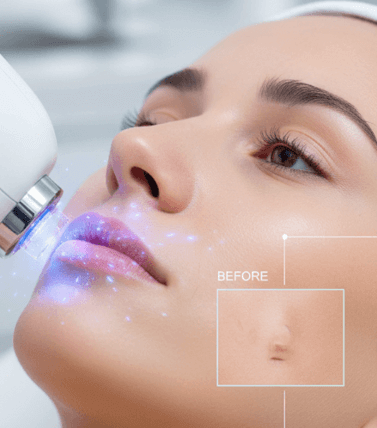Treatment Overview
Pico Laser therapy has become increasingly popular in Korea not only for pigmentation and skin rejuvenation, but also for redness and flushing associated with rosacea, post-acne erythema, and vascular sensitivity. Unlike traditional vascular lasers that directly target blood vessels, pico lasers deliver ultra-short picosecond pulses that stimulate collagen remodeling, reduce post-inflammatory redness, and improve overall skin tone with minimal downtime.
In Korean dermatology, pico lasers are often integrated with V-Beam (PDL), cooling masks, and barrier-repair therapies for comprehensive redness management. Their precision allows treatment of diffuse redness, flushing, and acne-related erythema while also improving skin texture and clarity.
For redness and flushing, Pico Laser Therapy:
- Reduces diffuse erythema and post-acne redness.
- Improves skin texture and barrier stability.
- Minimizes vascular sensitivity by strengthening dermal support.
- Provides gentle yet effective results with less downtime than traditional lasers.
Purpose & Benefits
- Redness Reduction: Helps fade diffuse vascular redness and post-inflammatory erythema.
- Skin Remodeling: Stimulates collagen production to stabilize vessels.
- Texture Improvement: Smooths skin while evening out tone.
- Minimal Downtime: Gentle on sensitive, redness-prone skin.
- Combination-Friendly: Often paired with vascular lasers, cooling masks, and soothing infusions.
Ideal Candidates
Pico Laser Therapy in Korea is recommended for:
- Patients with post-acne erythema or diffuse redness.
- Individuals with rosacea and vascular sensitivity.
- Adults seeking dual benefits of redness reduction + skin rejuvenation.
- Patients with sensitive skin who cannot tolerate stronger lasers.
- Those enrolled in clinic-supervised multi-step programs for redness.
Comparison with Other Treatments
- Pico Lasers: Best for diffuse redness, post-acne marks, and texture enhancement.
- Vascular Lasers (V-Beam, PDL, Nd:YAG): Directly target visible vessels; stronger for persistent flushing.
- Fractional Lasers: Improve redness + scars/texture; more downtime.
- Chemical Peels: Gentle redness reduction; surface-level only.
- Antibiotics (Doxycycline, Minocycline): Internal anti-inflammatory effect; no resurfacing.
- Beta-Blockers (Propranolol, Carvedilol): Systemic flushing control; no skin remodeling.
- Erythema-Reducing Creams: Daily topical relief; short-term action.
Possible Risks & Complications
Pico lasers are safe when performed by Korean dermatologists, but may cause:
- Temporary redness or swelling for 1–2 days.
- Mild dryness or flaking.
- Rare hyperpigmentation in darker skin tones if not carefully adjusted.
- Suboptimal results if used alone for severe vascular rosacea (usually paired with V-Beam).
Treatment Techniques Used
- Pico Laser Devices: Commonly used systems include PicoSure, PicoWay, and Discovery Pico.
- Pulse Delivery: Ultra-short pulses break down redness and trigger dermal healing.
- Session Frequency: Typically 3–5 sessions, spaced 3–4 weeks apart.
- Combination Therapy: Often combined with PDL/V-Beam for vessels and cooling infusions for comfort.
- Clinic Integration: Korean clinics emphasize multi-step protocols (pico + soothing mask + LED calming).
Recovery & Aftercare
- Immediately After: Skin feels warm; mild redness similar to a sunburn.
- 1–3 Days: Redness fades, flushing sensitivity improves.
- 2–4 Weeks: Skin tone appears more even, vascular triggers reduced.
Aftercare Tips:
- Apply soothing creams (Centella, panthenol, madecassoside).
- Avoid exfoliation or retinoids for 1 week.
- Use SPF 50+ sunscreen daily to prevent UV-triggered relapse.
- Stay hydrated and avoid overheating (saunas, hot baths) for several days.
Results & Longevity
- Short-Term (1–2 Weeks): Reduced post-acne redness, calmer complexion.
- Medium-Term (1–2 Months): Improved flushing stability and skin tone.
- Long-Term: Sustained results with yearly maintenance and combination therapy.
Treatment Process in Korea
- Consultation & Diagnosis – Dermatologist assesses redness severity and skin sensitivity.
- Preparation – Numbing cream may be applied for comfort.
- Laser Session – Pico laser pulses delivered across target areas.
- Clinic Add-Ons – Cooling masks, LED therapy, and herbal infusions applied immediately after.
- Follow-Up – 3–5 sessions recommended for optimal results, with periodic maintenance.
Why Korea is a Top Destination
- Korea is a global leader in pico laser technology with the latest devices.
- Dermatologists use multi-step redness programs (pico + vascular laser + moisture infusion).
- More affordable compared to Western dermatology clinics.
- Emphasis on safe protocols for sensitive, redness-prone skin.
- Clinics integrate post-laser soothing therapies to minimize downtime.
Cost Range (Detailed Breakdown)
Pricing for Pico Laser Therapy in Korea for redness & flushing:
- Single Pico Laser Session: USD 200 – 400.
- Package of 3–5 Sessions: USD 800 – 1,800.
- Consultation Fee: USD 20 – 50.
- Clinic Add-Ons (Cooling mask, LED, herbal infusion): USD 50 – 150.
- Premium Redness Program (Pico + Vascular Laser + Barrier Infusion): USD 1,200 – 2,500.
Additional Costs in Korea:
- Soothing creams (Centella, propolis, panthenol): USD 30 – 80.
- Sensitive-skin sunscreens: USD 20 – 50.
💡 Patients often call pico laser the “gentle resurfacing redness fix”, since it smooths skin tone while calming redness without the downtime of stronger lasers.
Popular Clinics in Seoul
- Oracle Dermatology – Pico + V-Beam combo for redness and flushing.
- Banobagi Dermatology – Customized pico protocols with herbal infusions.
- Renewme Skin Clinic – Pico laser for post-acne erythema with LED therapy.
- View Plastic & Dermatology – Pico + fractional laser programs for redness and scarring.
- Chaum Anti-Aging Center – Premium redness protocols with pico laser, vascular lasers, and regenerative infusions.




